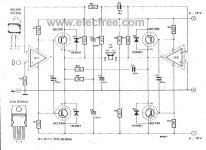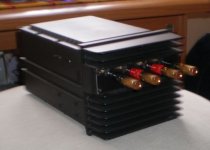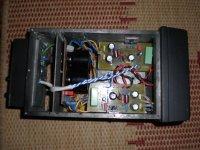you must follow the recommendations for maximum rail voltage as spelled out by National.zikinho said:Any experience with the PSU voltage regarding the sound? With what kind of rail voltage did you get the best sound?
This depends very much on the load impedance and the heatsink dissipation ability.
You can use a lower voltage but I do not recommend you adopt a higher voltage.
Generally, supply <=+-40Vdc for 8ohms, <=+-30Vdc for 4ohms.
How many LM1875s are you going to drive with 200 VA?zikinho said:Thanks, been thinking about 200VA, 2x18 ct tranny.
18 + 18 = 36
There are 5.56a of 36v in 200va.
You have 5.56 ampers there.
This is like: "That's kind of big, and you're planning to put it WHERE?"
The transformer is slightly oversize on amperage, possibly resulting in additional bass or a bit less mids at end result.
I would predict possible results at any point between fantastic or overdone.
There are 5.56a of 36v in 200va.
You have 5.56 ampers there.
This is like: "That's kind of big, and you're planning to put it WHERE?"
The transformer is slightly oversize on amperage, possibly resulting in additional bass or a bit less mids at end result.
I would predict possible results at any point between fantastic or overdone.
zikinho said:Ok. What rail voltage would i need to drive 4 Ohm speakers?
To answer that particular question, I'd have to say 21vdc rails (or less).
Optionally, you can use the transformer you already own along with a parallel LM1875 amplifier (two chips per each channel). That will work on either 4 ohm or 8 ohm speakers.
zikinho said:I have another tranny 150VA, 2x20VAC. Thanks for the answers.
20vac x 1.43 = 28.6vdc rails. This is nice for 16 ohm speakers.
Edit: But this voltage is so high that its not documented for use with LM1875. Please choose lower voltage.
You can use up to ±30 V with 8 Ohm speakers and up to ±25 V with 4 Ohm speakers. The latter could run into heatsinking limits.
If you have the 200 VA 2x18 V transformer lying around, use it. The voltage is okay and the power,...
well, you will have lots of headroom even with a two-channel amplifier. 😀
If you have the 200 VA 2x18 V transformer lying around, use it. The voltage is okay and the power,...
well, you will have lots of headroom even with a two-channel amplifier. 😀
pacificblue said:You can use up to ±30 V with 8 Ohm speakers and up to ±25 V with 4 Ohm speakers. The latter could run into heatsinking limits.
If you have the 200 VA 2x18 V transformer lying around, use it. The voltage is okay and the power,...
well, you will have lots of headroom even with a two-channel amplifier. 😀
There's a problem with the thermal junction, along with a few things I didn't want to mention because there could be electroshock or full-rail DC offset from a damaged chip because of what happens when it has expired.
Okay, so I gave conservative figures and you caught me. 😉
Any moment, I expect AndrewT to come along and tell me that my conservative figures are too high.
What can be done?
Maybe this:
Attachments
@PacificBlue Look at that! There's an exposed heatsink and a ground reference within 1 cm of each other. My voltage figures were correct. I gave the voltage figures assuming an insulator pad will be used with LM1875 for safety.
@zikinho Its not difficult to create a parallel LM1875 amplifier. That can use your 18vac+18vac transformer along with either 4 ohm or 8 ohm speakers.
@zikinho Its not difficult to create a parallel LM1875 amplifier. That can use your 18vac+18vac transformer along with either 4 ohm or 8 ohm speakers.
zikinho said:I have another tranny 150VA, 2x20VAC. Thanks for the answers.
Is this a center tap (3 wire output) or is it a dual secondaries (4 wire output)? I ask, because it is possible to create a very inefficient rectifier for a dual secondaries transformer. Some purposeful inefficiency at the rectifier will drop the rail voltage. This is just slightly complex to do, and there's no need to discuss all that bother if that is a center tap transformer for which the technique wouldn't make a sufficient voltage drop.
danielwritesbac said:
Is this a center tap (3 wire output) or is it a dual secondaries (4 wire output)? I ask, because it is possible to create a very inefficient rectifier for a dual secondaries transformer. Some purposeful inefficiency at the rectifier will drop the rail voltage. This is just slightly complex to do, and there's no need to discuss all that bother if that is a center tap transformer for which the technique wouldn't make a sufficient voltage drop.
It is a center tap. Both of them are.
Well, the 18+18vac transformer can be used with a parallel LM1875 amplifier on either 4 ohm or 8 ohm speakers. Its a pretty good option because it solves a difficult problem with LM1875's current handling capacity.
When used in parallel, it spots half the load (it sees your 4 ohm speakers as 8 ohm speakers).
When used in parallel, it spots half the load (it sees your 4 ohm speakers as 8 ohm speakers).
- Status
- Not open for further replies.
- Home
- Amplifiers
- Chip Amps
- LM1875 PCB, Which To Use


